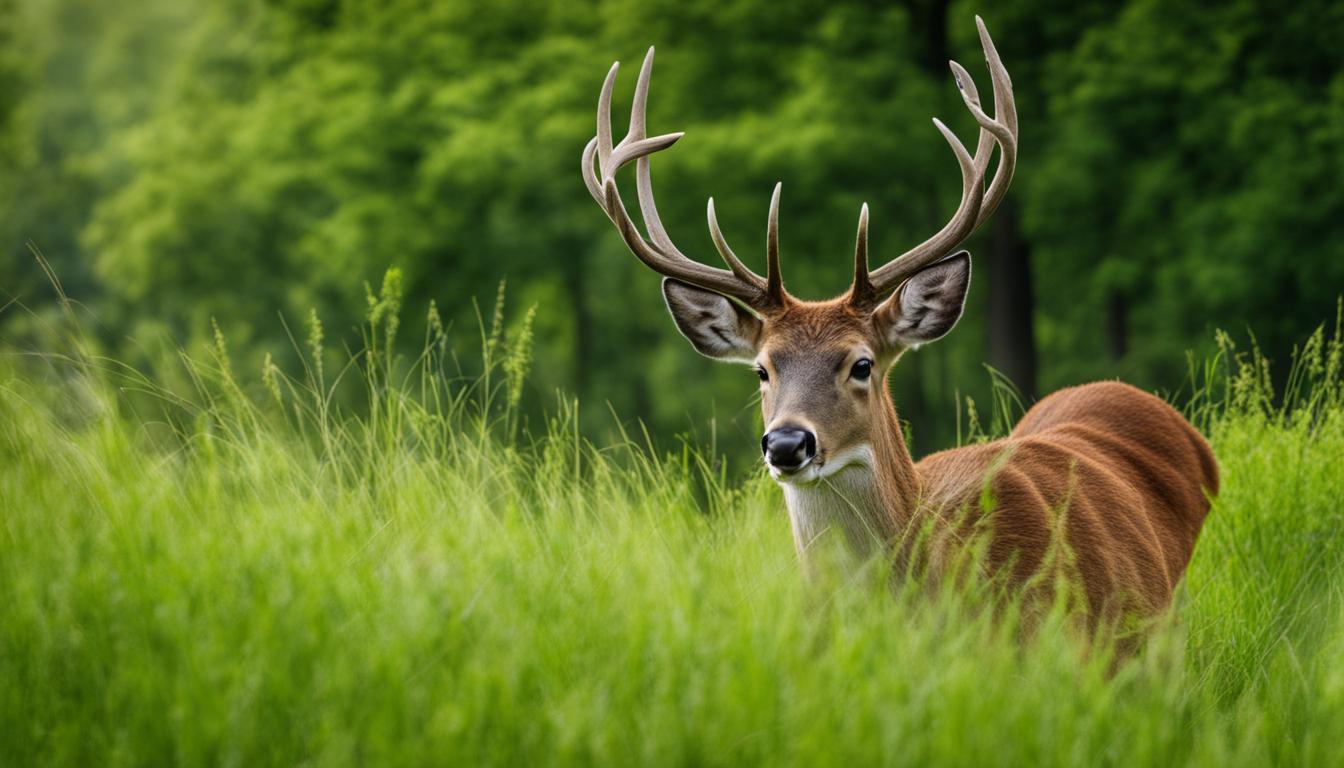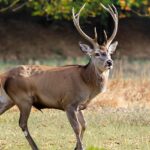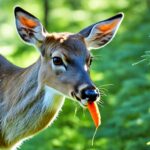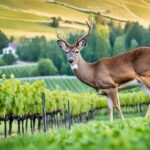If you’ve ever wondered about deer feeding habits, you may have asked yourself, “Do deer eat grass?” While grass is part of their diet, it’s important to understand that deer have a diverse food preference and do not solely rely on grass for sustenance. In this article, we’ll explore the wildlife diet of deer and delve into their deer foraging behavior.
Deer are herbivorous animals and have evolved to consume a variety of crops, grasses, vegetation, acorns, nuts, and browse. They require a significant amount of food daily, needing to consume 6 to 8 percent of their body weight in green foliage and browse to maintain their health. While grass is not their primary source of food, it is still an essential part of their dietary intake.
Deer have distinct preferences when it comes to foraging. They are known to browse on certain tree species, such as conifers and hardwood trees like maple and oak. These tree species provide deer with the necessary nutrients. However, it’s important to note that overbrowsing by deer can have a significant impact on the growth of tree seedlings, leading to ecological imbalances in certain habitats.
Interestingly, deer also exhibit selective behavior and avoid certain plants. They typically steer clear of invasive species and ferns, as these plants are less digestible for them.
Identifying deer browse is crucial for understanding their deer feeding habits and protecting tree seedlings. By assessing their foraging behavior, we can develop strategies to manage deer populations and maintain a healthy ecological balance in wildlife habitats.
Content Highlights
ToggleKey Takeaways:
- Deer have a diverse diet that includes crops, grasses, vegetation, acorns, and nuts.
- Grass is not the main source of food for deer, but it is still part of their diet.
- Deer prefer browsing on certain tree species like conifers and hardwood trees.
- Overbrowsing by deer can negatively impact the growth of tree seedlings.
- Deer exhibit selective behavior and avoid certain plants, such as invasive species and ferns.
Seasonal Dietary Preferences and Feeding Strategies of Deer
Deer, like other herbivorous animals, have distinct feeding habits that vary throughout the year based on the availability of food. Understanding their natural diet and grazing patterns is essential for wildlife conservation and management.
In the spring, deer have specific dietary requirements as they need protein to replenish muscle loss and support antler growth in bucks, as well as for the pregnancy of does. During this season, they focus on consuming young shoots, green vegetation, and browse for the necessary nutrients.
As summer arrives, deer need a significant amount of protein for energy and minerals to support their overall health and development. They rely on a diverse range of grasses, forbs, and woody plants to meet these nutritional needs.
With the onset of fall, the feeding habits of deer shift again. During this time, they require more fats and carbohydrates to prepare their bodies for the breeding season, known as the rut, and the upcoming winter. To meet these requirements, deer focus on foraging for acorns, fruits, nuts, and other high-energy foods.
In winter, when the availability of fresh green foliage decreases due to snow cover and plant dormancy, deer rely on woody plants, such as twigs and buds, for food. They also search for leftover fruits and nuts still present on the ground. In harsh conditions, deer may adapt their feeding behavior to browse under the snow to find available food sources.
It is important to note that supplemental feeding provided by humans can offer additional resources for deer during winter. However, caution should be exercised to avoid over-dependence and negative consequences such as the spread of diseases or changing the natural habitat dynamics.
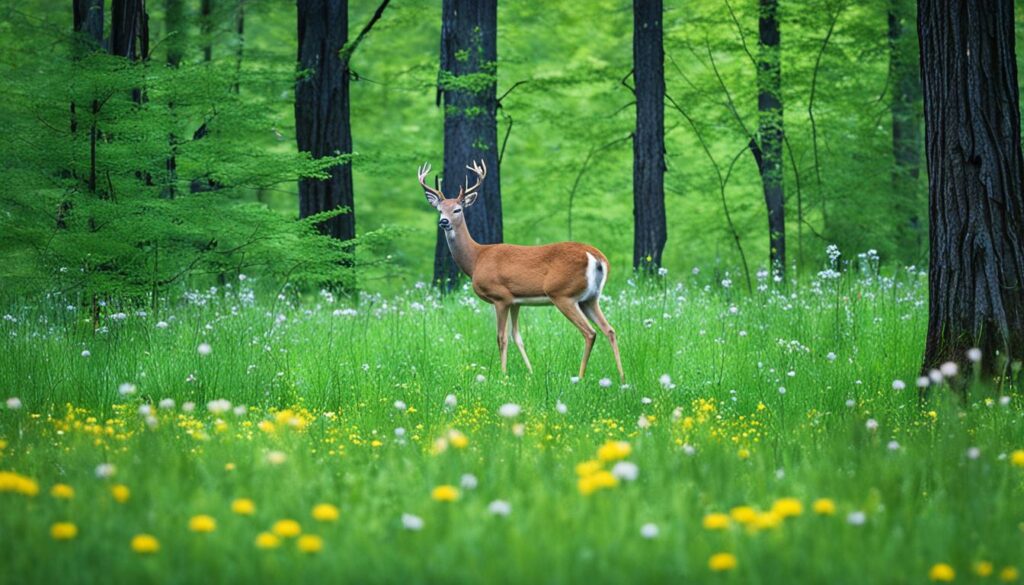
Understanding the seasonal dietary preferences and feeding strategies of deer is crucial for conservationists, landowners, and wildlife enthusiasts. By promoting the natural diet and grazing patterns of deer, we can help ensure their well-being and support healthy wildlife ecosystems.
Adaptations and Survival Strategies of Deer in Winter
During the winter months, deer face the challenge of finding food to sustain themselves. They have adapted their foraging behavior and feeding strategies to ensure their survival in harsh conditions. Deer rely on a combination of natural foraging and woody browse to obtain the necessary nutrients.
Deer are browsing animals, meaning they consume a variety of plant species to meet their dietary needs. They feed on woody plants like trees and shrubs, as well as grasses and forbs when available. In addition to natural vegetation, deer also take advantage of supplemental food sources such as agricultural crops like corn, soybeans, and grains. Fruits and nuts, including acorns, apples, and berries, provide them with important nutrients and energy.
One remarkable adaptation of deer is their ability to search for food under the snow. When food sources become scarce, they are capable of shifting their dietary preferences based on seasonal availability. Landowners and conservationists often establish food plots and managed feeding areas to help deer survive the winter months.
Moreover, deer exhibit physiological adaptations to conserve energy during colder months. They gradually slow down their metabolism and rely on stored body fat as a source of energy. These survival strategies enable deer to endure the challenges of winter and maintain their populations.
- California Deer Hunting Guide: Seasons, Rules, Permits, and More - 26 June 2024
- Arkansas Deer Season 2024 [Schedules, Licenses, Bag Limits & More!] - 26 June 2024
- 2024 Arizona Deer Season New Dates & Rules! - 25 June 2024
